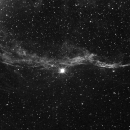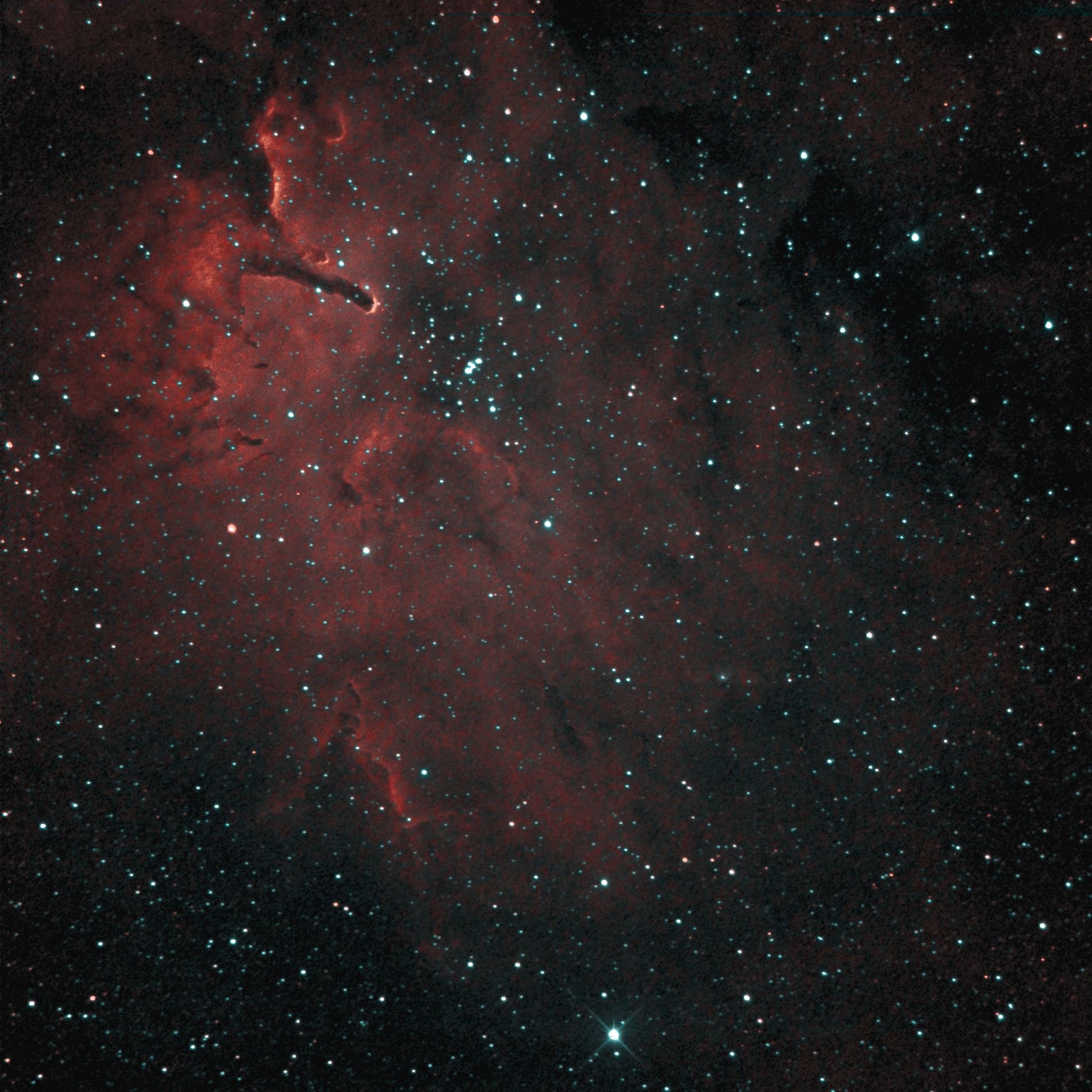 |
Rosette Nebula HOO-palette 1, 16, 17 and 18 february 2025 FTF2020-M full-frame monochrome CCD camera Leica f=300mm telephoto lens at f/D=4.0 on Fork-mount Field of View: 3.5 x 4.2 degrees Filters: Baader Planetarium H-alpha & Oiii with a 6.5nm bandwidth Exposure: H-alpha 112x180 sec and OIII 105x180 sec |

Veil East HOO-palette 27/28 aug 2024 25cm Newton f=882mm f/D=3.5 FTT1010-M CCD camera FoV: 0.76 x 0.76 degr Exp.: H-alpha 102x150sec OIII 83x150sec. BW 6.5nm |
 |
Veil or Cirrus Nebula HOO palette, stars removed 27/28 aug 2024 & 24 sep 2023 FTF2020-M CCD camera with f=300mm tele-obj. at f/D=4 on Fork-mount FoV: 2.0 x 2.0 degr Exposure: H-alpha 132x3min OIII 79x3min. BW 6.5nm |
| (Click here for earlier Veil Nebula images/attempts: 2007, 2004 and 2003) |
|
M42 imaged with SII, H-alpha and OIII narrow-band filters (Baader Planetarium, 6.5-8.5nm bandwidth), shown in three different ways. To the left H-alpha is shown in Red while the OIII image is distributed over Green (100%) and Blue (100%) to obtain the characteristic teal colour. The middle image has the same colour assignment and is unsharp masked, i.e. the luminance of the image was devided by a smoothed version of itself, lowering the intensity of the central part of the nebula and revealing the (nearly overexposed) trapezium star cluster. The image to the right shows M42 with H-alpha again assigned to Red (150%), S-II to Green (400%) and OIII to Green (80%) and Blue (100%). In order to have a clear effect, the Sulfur contribution had to be increased 4-fold. Images are obtained on february 8, 2023, with the FTT1010-M CCD camera and the f/D=3.5 Newton configuration described below (and in the equipment section, see here). M42 is a relatively bright object and for H-alpha and OIII short, 60-second exposures were needed to avoid overexposure of the central part: H-alpha 19x60 seconds, OIII 30x60seconds. The Sulfur contribution is much weaker and 16 exposures of 120 seconds were acquired. The images cover a 0.8x0.8 degree field of view, are sharpened and shown with a gamma of 2.2. The luminance is based on the (photopic) eye sensitivity for the H-alpha wavelength (656nm: sensitivity 0.08) and OIII wavelength (501nm: sensitivity 0.34). Thus L=0.08*H-alpha+0.34*OIII. |
Horse nebula HOO 14/27/28 february 2023 H-alpha 155x2min OIII 95x2min FoV 0.73x0.73 degrees Gamma 2.0 Intenser red contributions are shown with increasing whiter appearance The image is sharpened and rotated 90-degrees (CCW) |
 |
 |
 |
 |
| M42, HOO | M42, HOO, Unsharp masked. |
M42, HSO | Horsehead nebula |
|
Images (above and below) obtained with the FTT1010-M CCD camera and my latest Newton telescope. In fact it is a modified Cassegrain telescope with a 25cm, f=1091mm primary. By adding a
plane-convex lens close to the CCD the effective focal length is reduced to f=882mm and the f/D is improved from 4.3 to 3.5. Without this lens, coma of the parabolic primary over the 12mmx12mm focal plane of the CCD is substantial. The plano-convex lens reduces coma and increases sensitivity by some 50% (which compensates for the relatively low quantum efficiency of the CCD's I'm (still) using). For more details click here. The images are cropped to 0.5x0.5 degrees of the 0.8x0.8 degrees field of view. The bandwidth of the H-alpha and OIII filters are 6.5nm and 8.5nm (Baader-Planetarium). |
Images made with the FTF2020-M CCD camera equipped with a Baader H-alpha filter (7nm bandwidth) and with either the 25cm Newton using a coma-corrector resulting in f/D=4.7 or a Leica f=300mm teleobjective at F#4 |
 |
 |
 |
 |
| IC59&IC63, 7 december 2008 25cm Newton f/D=5.7 with coma-corrector f/D=4.7 FTF2020-M CCD Baader H-alpha filter 31 exposures of 3 min. FoV: 1.1x0.9 degr |
IC443, 10 february 2008 25cm Newton f/D=5.7 (Reprocessed 15 dec 2024) FTF2020-M CCD with Baader H-alpha filter 54 images of 150 sec FoV: 0.88x0.88 degr |
Detail Pelican nebula 22 october 2007 25cm Newton f/D=5.7 FTF2020-M CCD, binned Baader H-alfa filter Exposure: 50x180sec waxing gibbous moon nearby! FoV: 0.79x0.95 degr |
NGC7635 and M52 13 october 2007 25cm Newton f/D=5.7 FTF2020-M CCD Baader H-alfa filter Exposure: 29x180sec FoV: 0.93x0.93 degr |
 |
 |
 |
 |
| Veil nebula west 13 and 14 october 2007 (Reprocessed 2024. Old version here.) 25cm Newton f/D=5.7 FTF2020-M CCD Baader H-alfa filter Exposure: 59x180sec FoV: 0.67x0.93 degr |
vdB142 in IC1396 15 september 2007 25cm Newton f/D=5.7 FTF2020-M CCD, binned Baader H-alpha filter Exp.: 41x150sec FoV: 0.95x0.82 gr |
Planetary nebula PK205 22 january 2007 25cm Newton,f/D=5.7 FTT1010-M CCD H-alpha filter (10nm) Exposure: 48x100sec. FoV: 0.36x0.36 gr. |
NGC1491 22 january 2007 25cm Newton,f/D=5.7 FTT1010-M CCD H-alpha filter (10nm) Exposure: 55x90sec. FoV: 0.28x0.28 gr. |
 |
 |
 |
 |
| North America and Pelican nebula, 15 october 2006 300mm f#4 teleobjective FTF2020-M CCD H-alpha filter (10nm) Exposure: 24x3min. FoV: 4.5x4.5gr. |
NGC6888 Crescent nebula 20 september 2006 300mm f#4 teleobj. FTT1010-M CCD H-alpha filter (10nm) Exposure: 83x90 sec FoV: 0.44x0.44gr. |
M17, Swan or Omega nebula 4 july 2006 25cm Newton,f/D=5.7 FTF2020-M CCD H-alfa filter (10nm) Exposure: 30x80sec FoV: 0.96x0.96gr. |
M16, Eagle nebula 3 july 2006 25cm Newton,f/D=5.7 FTF2020-M CCD H-alfa filter (10nm) Exposure: 58x60sec FoV: 0.96x0.96gr. |


|


|
 |
 |
19 december 2004 prime focus 25cm Newton FTF2020-M with H-alpha filter and coma-corrector at f/D=4.7 Exposure: 44x3 minutes Field of View: 1.1x1.1 degrees Lower detail: 0.66x0.44 deg. |
23 november 2004 prime focus 25cm Newton FTF2020-M with H-alpha filter and coma-corrector at f/D=4.7 Exposure: 59x2.5 minutes Field of View: 0.7x0.7 degrees Lower detail: 0.3x0.2 deg. 11 october 2004 f=300mm teleobjective at F#5.5 FTF2020-M with H-alpha filter(Bandwidth 10nm) Exposure: 56x3 minutes Field of View: 4.0x4.0 degrees 30 september 2002 Prime focus f=1455cm Newton scope at F/D=5.7 FTF2020-M with RG630 and IR cutt-off filter Transmission 630-720nm Exposure: 35x2 minutes Field of View: 1x1 degree. |
| On the "left", a recently taken image of nebulae in the vicinity of Gamma-Cygni is given. A f=300mm tele-objective, fitted with an H-alpha filter
(Edmund optics) was used to create this nearly 5x5 degrees field of view. Some distinctly bright and dark nebula are
visible of which three were photographed previously in more detail using the 10" Newton (f=1455mm). |
| These images are captured with my latest CCD-camera with FTF2020-M CCD chip (2048x2048 monochrome chip) in binning mode (1024x1024 pixels of 24x24 um) |
| The here presented four images are made using an H-alpha IF-filter (10nm bandwidth, Edmund Optics) |
| Images below: Prime focus f=1455cm Newton scope at F/D=5.7, D=255mm. Field of View: 1x1 degree. RG630 and IR cutt-off filter. Effective transmission 630-720nm and thus mainly H-alpha. Image grey scale with Gamma=2 to reveal the weaker parts of the nebula. |




































